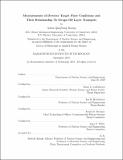| dc.contributor.advisor | Brian L. LaBombard. | en_US |
| dc.contributor.author | Kuang, Adam QingYang. | en_US |
| dc.contributor.other | Massachusetts Institute of Technology. Department of Nuclear Science and Engineering. | en_US |
| dc.date.accessioned | 2020-09-25T20:03:30Z | |
| dc.date.available | 2020-09-25T20:03:30Z | |
| dc.date.copyright | 2019 | en_US |
| dc.date.issued | 2019 | en_US |
| dc.identifier.uri | https://hdl.handle.net/1721.1/127707 | |
| dc.description | This electronic version was submitted by the student author. The certified thesis is available in the Institute Archives and Special Collections. | en_US |
| dc.description | Thesis: Ph. D. in Applied Plasma Physics, Massachusetts Institute of Technology, Department of Nuclear Science and Engineering, 2019 | en_US |
| dc.description | Cataloged from student-submitted PDF of thesis. | en_US |
| dc.description | Includes bibliographical references. | en_US |
| dc.description.abstract | Cross-field filamentary transport in the scrape-off layer (SOL) is important for controlling SOL profiles, main-chamber recycling fluxes, and divertor operation. However, questions remain about the extent to which divertor target conditions play a role in setting transport levels. The Alcator C-Mod SOL is well diagnosed and extensively characterized, making it an ideal platform to assess the impact of divertor target conditions on SOL filamentary transport and the resultant upstream profiles, in particular, density shoulder formation. To facilitate the investigation, a set of high heat flux handling, flush-mounted rail Langmuir probes were designed for the Alcator C-Mod divertor. They were validated and proved to be robust, reliable diagnostics. Main chamber SOL fluctuations and density profiles were observed and found to be strongly correlated with divertor target conditions when the core plasma Greenwald fraction was increased. | en_US |
| dc.description.abstract | However, no trend was observed when local changes to near SOL divertor conditions were made using N₂ impurity seeding. To understand these results, a numerical model for filament transport was constructed that includes realistic magnetic geometry effects (e.g. magnetic shear) and collisionality profiles, both of which have been identified by theory to be important parameters. In validating the numerical model, a discrepancy was highlighted: experimental observations find fluctuation timescales in the SOL to be independent of location, whereas theories assume that timescales are set by local parameters--not accounting for the nonlocal effect of filaments being formed in the near SOL and propagating outwards. | en_US |
| dc.description.abstract | The numerical model reveals that strong distortions to the magnetic geometry in the near SOL, due to proximity to the X-point, electrically disconnect the main chamber SOL from divertor target conditions, offering an explanation for the experimental observations, and further suggesting that divertor heat flux mitigation may be optimized without direct impact on main chamber plasma profiles. When the divertor is electrically connected to the main chamber SOL, simulations indicate that increasing divertor collisionality causes a decrease to filament velocity, contrary to published literature. In summary, the combined impact of SOL collisionality and magnetic geometry effects were found to be strong controlling parameters on cross-field filamentary transport consistent with theoretical expectations, providing strong motivation for including these effects in SOL transport simulations and in interpreting experimental results. | en_US |
| dc.description.statementofresponsibility | by Adam QingYang Kuang. | en_US |
| dc.format.extent | 232 pages | en_US |
| dc.language.iso | eng | en_US |
| dc.publisher | Massachusetts Institute of Technology | en_US |
| dc.rights | MIT theses may be protected by copyright. Please reuse MIT thesis content according to the MIT Libraries Permissions Policy, which is available through the URL provided. | en_US |
| dc.rights.uri | http://dspace.mit.edu/handle/1721.1/7582 | en_US |
| dc.subject | Nuclear Science and Engineering. | en_US |
| dc.title | Measurements of divertor target plate conditions and their relationship to scrape-off layer transport | en_US |
| dc.type | Thesis | en_US |
| dc.description.degree | Ph. D. in Applied Plasma Physics | en_US |
| dc.contributor.department | Massachusetts Institute of Technology. Department of Nuclear Science and Engineering | en_US |
| dc.identifier.oclc | 1196378698 | en_US |
| dc.description.collection | Ph.D.inAppliedPlasmaPhysics Massachusetts Institute of Technology, Department of Nuclear Science and Engineering | en_US |
| dspace.imported | 2020-09-25T20:03:29Z | en_US |
| mit.thesis.degree | Doctoral | en_US |
| mit.thesis.department | NucEng | en_US |
